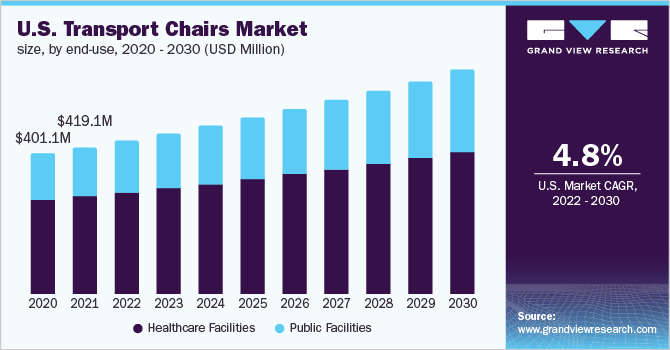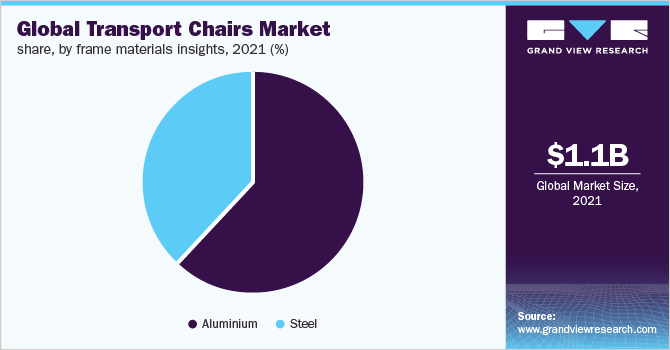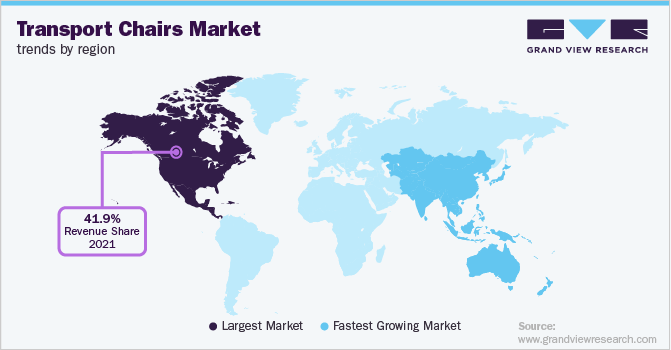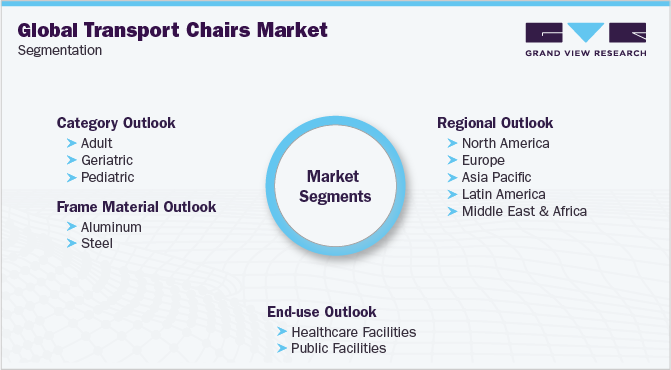- Home
- »
- Medical Devices
- »
-
Transport Chairs Market Size, Share & Trends Report, 2030GVR Report cover
![Transport Chairs Market Size, Share & Trends Report]()
Transport Chairs Market Size, Share & Trends Analysis Report By Category (Pediatric, Adult, Geriatric), By End-use (Healthcare Facilities, Public Facilities), By Frame Materials (Aluminum, Steel), By Region, And Segment 2022 - 2030
- Report ID: GVR-4-68039-957-4
- Number of Report Pages: 111
- Format: PDF, Horizon Databook
- Historical Range: 2018 - 2020
- Forecast Period: 2021 - 2030
- Industry: Healthcare
Report Overview
The global transport chairs market size was valued at USD 1,096.7 million in 2021 and is expected to grow at a compound annual growth rate (CAGR) of 5.7% from 2022 to 2030. Rising rates of osteoporosis and arthritis, as well as the accessibility of modern, portable, and compact mobility aids, are the main factors driving the industry's growth. With the use of automation and additive features, transport chairs are developed in a short time. In addition, the frame materials category has seen an increase in inventions, which is contributing to the expansion of this category of items. Due to an increase in patients at healthcare institutions, particularly the elderly patients since they were more sensitive to COVID-19, the demand for transport chairs increased dramatically during the pandemic.

More transportation and mobility equipment were needed due to the growing number of patients. According to the WHO assessment, the COVID-19 outbreak has disproportionately negative effects on people with disabilities. According to estimates, 46% of people aged 60 years and above have a disability. Rising accident cases & surgery volumes, technological breakthroughs, innovation, increased fall rates driving up the need for mobility aids, and high prevalence of osteoporosis & arthritis are some of the key growth drivers. The CDC estimates that there are 58.5 million adults in the United States who have arthritis, or 24% of all adults. With a yearly cost of USD 303.5 billion in medical care and lost wages, it is the main cause of work incapacity.
The most common kind of arthritis is osteoarthritis. Other variations of this disease include lupus, gout, and rheumatoid arthritis. Arthritis symptoms include pain, discomfort, stiffness, and swelling in or around the joints. 13.7% of people with a disability have a mobility disability with serious difficulty walking or climbing stairs. The industry has changed as a result of the emergence of power chairs, and many wheelchair manufacturers are focused on this possibility and spending money on R&D to release cutting-edge wheelchair gadgets. Powerchairs provide patients with greater comfort, aid, and agility while also requiring less physical effort from them.
Currently, powerchairs come with a variety of control functions, nonlinear processing circuits, guidance sensors, navigation, and pulse steering drives. manufacturers like Medline, Invacare, Carex, and Nova offer transport wheelchairs with handbrake systems, companion-activated wheel locking, and anti-tip wheels. Drive transport chairs are available from DeVilbiss Healthcare with distinctive footrests that can be neatly secured to the side of the frame for simple storage. Thus, it is anticipated that these new designs and technologies would accelerate market growth. The COVID-19 pandemic has increased the demand for transport chairs as healthcare facilities were forced to provide continuous patient transportation.
Mobility aids were needed to carry several serious patients who had been diagnosed with COVID-19 from one department to another and for various treatments and examinations. The medical devices supply chain was severely affected during the period but demands for transport chairs were successfully met. However, the COVID-19 pandemic has had a significant and likely long-lasting impact on the employment landscape, transportation services, and health center operations. However, the medical devices supply chain was severely affected during the period.
Category Insights
The adult population segment accounted for the largest share of more than 47.50% in 2021 and is anticipated to witness steady growth over the forecast period. This can be attributed to the increasing incidence of arthritis, osteoporosis, etc. The geriatric population category is anticipated to register a significant CAGR from 2022 to 2030. This is brought on by the rise in the population of elderly people. For instance, in the U.S., there are 255,369,678 adults. According to Urban Institute, the number of people aged 65 years and above in the U.S. will double over the next four decades, reaching 80 million by 2040.
The increasing geriatric population coupled with the rising cases of falls in the elderly is projected to boost the demand for mobility aids during the forecast period. The greatest risk factor for the emergence of chronic diseases is aging. As a result, the prevalence of chronic illnesses like diabetes, Cardiovascular Diseases (CVDs), arthritis, and other lifestyle disorders is anticipated to increase along with the growing aging population, fueling industry expansion. Key target populations for personal mobility equipment like transport wheelchairs are the elderly population and people with limb limitations.
Frame Materials Insights
Based on frame materials, the global industry has been further bifurcated into aluminum and steel. In 2021, the aluminum frame materials segment dominated the industry and accounted for the maximum share of more than 61.50% of the global revenue due to the high demand for these chairs. Although steel is cheaper than aluminum, it absorbs heat and is more prone to corrosion. Aluminum is more malleable and ductile than steel, which is 2.5 times denser to be exact. It can be bent or extruded into a variety of different forms or profiles without cracking or breaking. Aluminum chairs are highly preferred for smooth patient transportation.

Aluminum has a better strength-to-weight ratio than mild steel, which results in a reduction in the mobility device’s overall weight. Transport chairs are mostly moved by the patient’s caretaker. In many cases, the chairs have to be carried along with the patient wherever needed, and hence the less heavy chair is preferred. In addition, aluminum is corrosion-resistant, which increases the durability and quality of the chair making it highly durable. Therefore, throughout the forecast period, these factors are anticipated to fuel the aluminum segment growth.
End-use Insights
The healthcare facilities segment accounted for the maximum share of more than 65.00% in 2021. The primary healthcare facility type where the use of transfer chairs is greatest is hospitals. Hospitals end-use dominated the healthcare facilities segment in 2021. The majority of mobility equipment is utilized in hospitals for a patient’s physical movements. Hospital settings are preferable healthcare settings for treating serious illnesses, congenital problems, spinal cord trauma, and accidents involving the brain. For instance, A minimum stay of 11 days is required for spinal cord injuries, after which the patient is typically sent to a rehabilitation facility.
However, the hospital inpatient and outpatient care costs have increased, which may hamper the segment growth. The healthcare facilities segment will register a significant CAGR during the forecast period. The growing prevalence of osteoporosis & arthritis, accessibility of technologically advanced portable mobility aids, and the growing geriatric population are the key factors driving the segment growth. Public spaces, and notable airports, are anticipated to remain the second-most lucrative end-use segment over the projection period due to the rising travel rates, faster travel times, and improved accessibility for people with disability.
Regional Insights
North America held the dominant share of over 41.9% of the global revenue in 2021. The growing elderly population and the existence of a favorable reimbursement mechanism are responsible for this expansion. Throughout the forecast period, the regional market is expected to be driven by the increasing frequency of illnesses linked to lifestyle. In addition, the regional sector is expanding as a result of the presence of major companies, a sophisticated healthcare infrastructure, high levels of disposable income, and significant lifestyle changes. Due to the rising geriatric population, which signals a significant socioeconomic burden in this region. Asia Pacific is predicted to be the fastest-growing regional market over the projection period.

The region’s workforce is expected to shrink and public healthcare spending & the use of specialist medical chairs will subsequently rise. The U.S. Census Bureau’s research indicates that Japan has the world’s largest proportion of elderly people. Furthermore, it is anticipated that the market would rise as a result of the presence of international organizations like the United Nations Population Fund, which intends to support such nations in establishing and putting into practice national programs and policies. In addition, increasing discretionary income and ongoing R&D activities by major regional players to develop innovative products are expected to bolster the region’s growth over the coming years.
Key Companies & Market Share Insights
New frame material developments, collaborations, and regional expansions are key strategic initiatives undertaken by industry participants. For instance, in 2022, Carex Health Brands, Inc. announced its expansion in BOSTON, MA. Key players also focus on partnerships and mergers that will allow them to introduce new frame materials in different markets. Many companies like GF Health Frame Materials, Inc. have introduced recline wheelchairs and removable full support headrests as well as standing wheelchairs Some of the prominent players in the global transport chairs market include:
-
Carex Health Brands, Inc.
-
Stryker
-
Drive Medical Design & Manufacturing
-
Graham-Field Health Frame Materialss, Inc.
-
Invacare
-
Medline Industries
-
Sunrise Medical LLC
-
Karman Healthcare
-
NOVA
Transport Chairs Market Report Scope
Report Attribute
Details
Market size value in 2022
USD 1.14 billion
Revenue forecast in 2030
USD 1.7 billion
Growth rate
CAGR of 5.7% from 2022 to 2030
Base year for estimation
2021
Historical data
2018 - 2020
Forecast period
2022 - 2030
Quantitative units
Revenue in USD million/billion and CAGR from 2022 to 2030
Report coverage
Revenue forecast, company ranking, competitive landscape, growth factors, and trends
Segments covered
Category, frame materials, end-use
Regional scope
North America; Europe; Asia Pacific; Latin America; MEA
Country scope
U.S.; Canada; U.K.; Italy; France; Spain; Germany; China; Japan; India; Australia; South Korea; Brazil; Argentina; Mexico; Saudi Arabia; South Africa; UAE
Key companies profiled
Carex Health Brands, Inc.; Stryker; Drive Medical Design & Manufacturing; Graham-Field Health Frame Materialss Inc.; Invacare; Medline Industries; Sunrise Medical LLC; Karman Healthcare; NOVA
Customization scope
Free report customization (equivalent to up to 8 analysts' working days) with purchase. Addition or alteration to Category, regional & segment scope.
Pricing and purchase options
Avail of customized purchase options to meet your exact research needs. Explore purchase options
Global Transport Chairs Market Segmentation
This report forecasts revenue growth at global, regional, and country levels and provides an analysis of the latest industry trends in each of the sub-segments from 2018 to 2030. For this study, Grand View Research has segmented the global transport chairs market report based on category, frame materials, and end-use:

-
Category Outlook (Revenue, USD Million, 2018 - 2030)
-
Adult
-
Geriatric
-
Pediatric
-
-
Frame Material Outlook (Revenue, USD Million, 2018 - 2030)
-
Aluminum
-
Steel
-
-
End-use Outlook (Revenue, USD Million, 2018 - 2030)
-
Healthcare Facilities
-
Hospitals
-
Nursing Homes
-
Specialty Clinics
-
Others
-
-
Public Facilities
-
Airports
-
Shopping Malls
-
Others
-
-
-
Regional Outlook (Revenue, USD Million, 2018 - 2030)
-
North America
-
U.S.
-
Canada
-
-
Europe
-
U.K.
-
Italy
-
France
-
Spain
-
Germany
-
-
Asia Pacific
-
China
-
Japan
-
India
-
Australia
-
South Korea
-
-
Latin America
-
Brazil
-
Argentina
-
Mexico
-
-
Middle east and Africa
-
Saudi Arabia
-
South Africa
-
UAE
-
-
Frequently Asked Questions About This Report
b. The global transport chairs market size was estimated at USD 1,096.7 million in 2021 and is expected to reach USD 1.14 billion in 2022.
b. The global transport chairs market is expected to grow at a compound annual growth rate of 5.7% from 2022 to 2030 to reach USD 1.7 billion by 2030.
b. North America dominated the transport chairs market with a share of 41.9% in 2021. It is anticipated to grow substantially owing to the rising mobility disorders and advanced healthcare facilities in this region.
b. Some key players operating in the transport chairs market include Carex, Stryker, Drive Medical, Invacare, Medline Industries, Sunrise Medical, Karman, Novam and Others
b. An increasing population, growing product development, and a rising number of accidents causing disabilities are some of the key factors driving the transport chairs market for transport chairs market.
Share this report with your colleague or friend.
![gvr icn]()
NEED A CUSTOM REPORT?
We can customize every report - free of charge - including purchasing stand-alone sections or country-level reports, as well as offer affordable discounts for start-ups & universities. Contact us now
![Certified Icon]()
We are GDPR and CCPA compliant! Your transaction & personal information is safe and secure. For more details, please read our privacy policy.
We are committed towards customer satisfaction, and quality service.
"The quality of research they have done for us has been excellent."





